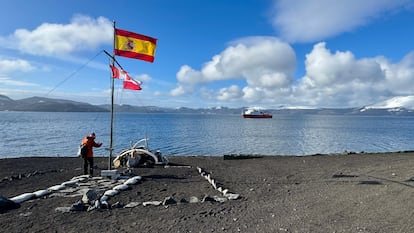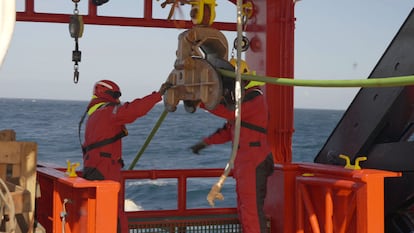Massive methane leaks detected in Antarctica, posing potential risks for global warming
A Spanish scientific expedition has discovered columns of gas emerging from the seabed. Geologists also warn about the possibility of huge landslides that could generate tsunamis


A team of Spanish scientists exploring the Antarctic seabed has detected “massive emissions” of methane, a gas with a capacity to warm the planet around 30 times greater than carbon dioxide (CO₂). The researchers, on board the ship Sarmiento de Gamboa, have observed columns of methane in the ocean up to 700 meters long and 70 meters wide, according to the geologists Ricardo León and Roger Urgeles, leaders of the expedition, in statements to EL PAÍS. These previously unknown emissions could potentially represent an environmental bomb for the planet’s climate.
What they have discovered is exactly what they feared. Scientists set sail on January 12 in search of these massive but at that point still hypothetical leaks. The compound accumulated on the seabed about 20,000 years ago through the decomposition of organic matter in the form of methane hydrates, a crystalline solid. “It is like ice that you could set on fire and it would burn,” explains Urgeles, of the Institute of Marine Sciences, based in Barcelona. The theory was that the thinning of the enormous Antarctic ice sheet, which began at the end of the last ice age, is causing a decrease in the weight on the land and a rise of the continent’s land mass; this phenomenon, known as post-glacial rebound, favors leaks of frozen methane hidden for millennia in the seabed.
Researchers looked for leaks on the edges of Antarctica, one of the regions of the planet hardest hit by global warming, with a rise in temperature of more than three degrees in just half a century. “We have estimated that in this area there are some 24 gigatons of carbon accumulated in methane hydrates, an amount equivalent to what all of humanity emits in two years,” warns Urgeles.

Frozen, solid methane is turning into methane gas. “These phenomena have already been recorded in the Arctic, but this is the first time they have been detected in Antarctica,” says León, from the Geological and Mining Institute of Spain. His team met two EL PAÍS journalists on Antarctica’s King George Island on February 8, the day they ended their expedition. Their results, still very preliminary, suggest that the gas is bubbling up from the subsoil along faults, often through mud volcanoes hundreds of meters above the seabed.
The Sarmiento de Gamboa research vessel, part of the Spanish National Research Council (CSIC), has been cruising the dangerous Antarctic seas for almost a month, taking water and sediment samples and performing X-rays of the subsoil. Methane hydrates, similar to ice, are stable at low temperatures and high pressures, but with the warming of the oceans and the decrease in the weight of the sea - due to the uplift of the Antarctic land mass - they become destabilized and the gas erupts. The methane columns observed by the researchers dissolve at about 150 meters from the ocean surface. Future analysis of the samples will reveal to what extent the gas is released into the atmosphere.
Geologists Ricardo León and Roger Urgeles warn of another threat. The instability of marine sediments can cause huge landslides on the continental slope, with the potential to generate tsunamis. “When methane hydrates turn into gas, they occupy a volume 160 times greater. If they do not dissipate quickly, they can cause huge landslides, such as the Storegga landslide in the Arctic,” stresses Urgeles, alluding to the largest known submarine landslide, which caused a tsunami that devastated the coasts of northern Europe some 8,150 years ago.
Wave heights reached 20 meters on the Shetland Islands in present-day Scotland, but the geological traces of the natural disaster can still be found all along the Norwegian coast, in Denmark and even in Greenland. “The Storegga landslide was of similar dimensions to the whole of Andalusia (in southern Spain) and coincided with periods of major climate change on Earth. Given the time of the landslide, one of the reasons could be that these changes caused a dissociation of methane hydrates and triggered the huge landslide,” warns León.
Sign up for our weekly newsletter to get more English-language news coverage from EL PAÍS USA Edition
Tu suscripción se está usando en otro dispositivo
¿Quieres añadir otro usuario a tu suscripción?
Si continúas leyendo en este dispositivo, no se podrá leer en el otro.
FlechaTu suscripción se está usando en otro dispositivo y solo puedes acceder a EL PAÍS desde un dispositivo a la vez.
Si quieres compartir tu cuenta, cambia tu suscripción a la modalidad Premium, así podrás añadir otro usuario. Cada uno accederá con su propia cuenta de email, lo que os permitirá personalizar vuestra experiencia en EL PAÍS.
¿Tienes una suscripción de empresa? Accede aquí para contratar más cuentas.
En el caso de no saber quién está usando tu cuenta, te recomendamos cambiar tu contraseña aquí.
Si decides continuar compartiendo tu cuenta, este mensaje se mostrará en tu dispositivo y en el de la otra persona que está usando tu cuenta de forma indefinida, afectando a tu experiencia de lectura. Puedes consultar aquí los términos y condiciones de la suscripción digital.
More information
Archived In
Últimas noticias
From Andorra to Gibraltar, a black market for Ozempic exploits its success: ‘They’re the most sought-after products in the world’
From Hungary’s Orbán to Chile’s Kast: How Trump helps turbo charge the far right
Magnets in their heads: How some animals guide themselves using the Earth’s magnetic field
The brief rise and retreat of Generation Z in Mexico
Most viewed
- Why we lost the habit of sleeping in two segments and how that changed our sense of time
- Trump’s obsession with putting his name on everything is unprecedented in the United States
- Charles Dubouloz, mountaineering star, retires at 36 with a farewell tour inspired by Walter Bonatti
- The Florida Keys tourist paradise is besieged by immigration agents: ‘We’ve never seen anything like this’
- Living in a motorhome due to soaring housing prices in Madrid: ‘I got used to it quickly, but I don’t idealize it’










































